





|
XL THROTTLE BODY TESTS
|
Quick Links:
|
Introduction
The introduction of the SE 58mm throttle body for XL models, in August 2015, generated something of a stir in Sportster circles, and people started asking questions.
The fact that HD was bundling it with a package of heads and cams that delivered all of 97hp had people wondering if a bigger throttle body was actually beneficial
at the 100hp level. Does a Sportster really need that big of a throttle body to make 100hp? How much does it bring to the party?
Well, up to that point, we had done some testing here and there with one of the HPI throttle bodies, since it was the only aftermarket piece on the market designed for XL's. We
had documented the results on the XL Forum, but nowhere else. And due to those results, we had an idea of what to expect from the SE piece. But we decided to get the SE piece and
go ahead and run the tests on it. What we've done here is documented all of our throttle body testing in one place, so you can review all the data right here on our web site.
In the event we collect more comparison data on these pieces, or we have the occasion to test other aftermarket pieces, we'll document those results here as well.
Since these tests were done at various times, and with various configurations of the bike - even two different bikes - we have to present the results independently of each other,
we can't just show you one big chart that has all the answers. So you'll have to wade through the sequence of events to really form the picture of what to do with your throttle body.
Sorry about that. If you're short on time, just read the section on the SE piece, since we also tested the stock throttle body in both ported and unported form at that time.
That's as close as we've got to an all-in-one result to look at.
Each of the throttle bodies we've tested also has a manifold associated with it. For the purpose of brevity, when we refer to the throttle body below, we're referring to the manifold as well.
|
Porting the Stock Throttle Body
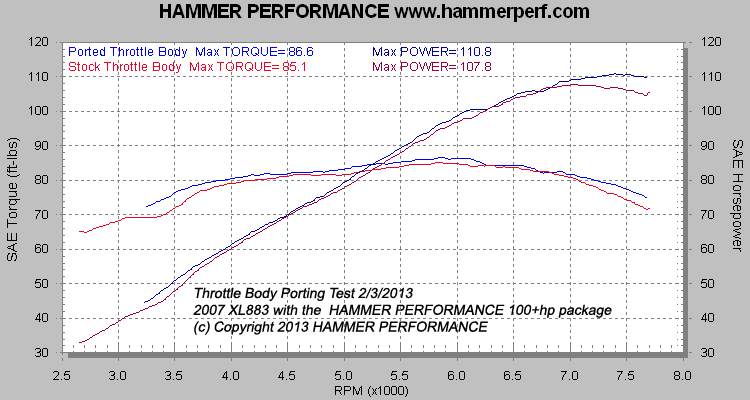
Comparison of the stock throttle body, ported and unported
Back in early 2013, we had just developed
our 100+hp 883-1250 conversion package for EFI bikes, and we got curious as to how much the stock throttle body was holding us back.
The stock throttle body has a 45mm throttle plate, which is big enough to flow a lot of air and support a lot of power. However, immediately downstream from the throttle plate,
the throttle body necks down to 41mm, passes into the manifold which
has a 41mm inlet, and then goes out the manifold outlets which are also 41mm. So while the throttle plate is a reasonable size, everything downstream from it is pretty restrictive.
There's not a lot of room to fix it with a die grinder, either. The throttle body is sealed to the manifold via an o-ring, and you can't enlarge the area very much at all before
you get into that o-ring groove. Likewise, the o.d. of the outlets is not very big, so there's not a ton of enlarging you can do there either. There is however a lot of casting flash
and other loss-inducing imperfections in the manifold casting, and these can be removed and smoothed out. Also the obstruction introduced by the injector bosses could be reduced as well.
We did those things, and what you see above is the result. You can pretty much ignore the differences below 7000rpm, a dyno's result is not 100% repeatable and most,
if not all of that
difference, is normal pull to pull variation. However, above 7000rpm, that's the effect of the porting work. Three horsepower for a $100 service on the throttle body is some pretty cheap power,
however, since it all comes in at the top of the chart only, and reaching 100+hp on this package does not require the service, we decided against making it a standard part of the 100+hp
conversion package.
UPDATE 1/31/19:We recently had the opportunity to redo this test, at just a little lower power level, and got this result:
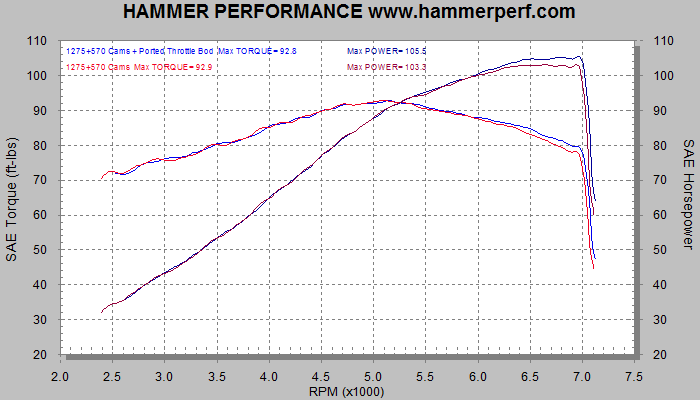
Second comparison of the stock throttle body, ported and unported
This result came from our shop mule 2007 XL883, but configured with stock EFI 1200 heads, flat top 1275 kit, and JACKHAMMER 570 cams.
Pretty much confirms the first result. Porting the throttle body at this level really does only a tiny little bit for you, and only at the very top of the sheet.
|
HPI 51mm Throttle Body
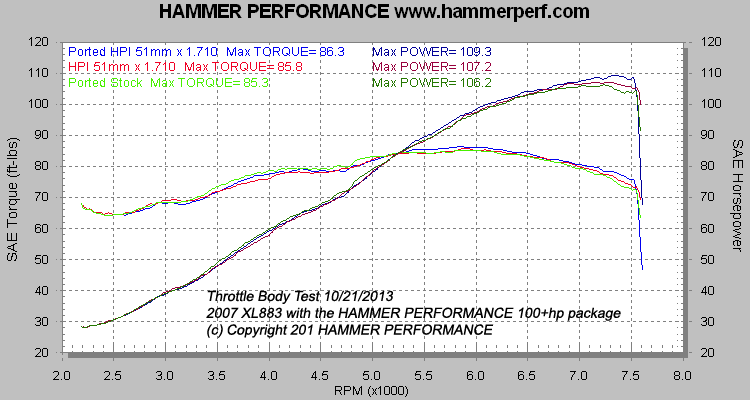
Comparison of the ported & unported HPI 51mm x 1.710 throttle body to the ported factory throttle body
Not long after we had ported and tested the stock throttle body, HPI introduced a 51mm throttle body for XL's, which was the first aftermarket offering. We were anxious to test it.
They had two versions of it available, one with 1.620" (41mm) manifold outlets for stock heads and another with 1.710" (43mm) outlets for ported heads. We went with the larger unit.
Later, HPI would come out with a 55mm version of this throttle body as well, but at the time, 51mm was the only option, so that's what we tested.
By this time, the engine on the test bike was not the same, we had run lots of experiments and still had some experimental parts in it, and it wasn't quite as strong as it was
when we had done the original test as described earlier. But it was still a reasonably strong steet bike, and at the time, we had not seen anyone else in the business who had made anywhere
near this power level with an EFI Sportster. So our thinking was, hey, if there's any bike out there that should benefit from this thing, it would be this one, right?
The result was disappointing, as you can see by comparing the red and green lines. One horsepower over our ported factory piece, for $790, just didn't make a lot of sense to us.
On top of that, this thing stuck way out as compared to the stock piece, and it required (and came with) it's own air cleaner as a result. We didn't much care for the piece at this point.
But in looking at it, in particular the manifold, we could see lots of room for improvement. Lots of casting flash, and some room to make the outlets bigger and remove some injector
boss obstruction along the way. We went after it with a die grinder, tested it again, and got the result shown in blue.
OK, now we're talking 3hp over our hand ported stock piece, which in our previoust test was 3hp over the unported stock piece. It was still all coming in at the very top of the sheet, though. However, you
could almost make an argument for the thing, although it was still some pretty expensive horsepower and it was still forcing you into their air cleaner that was sticking way out.
But if you want every last horsepower, this thing was there to help you get it. We mostly wondered what would happen if we tested it at a higher power level. Would it really shine at say 120hp?
It would be the winter of 2014-2015 before we would really answer that question. As we developed
our 110+hp package for 883-1250 conversions, and we were getting numbers north of 120hp, we
decided it was time to put the thing back on and see what it brought to the party. Here's what we got:
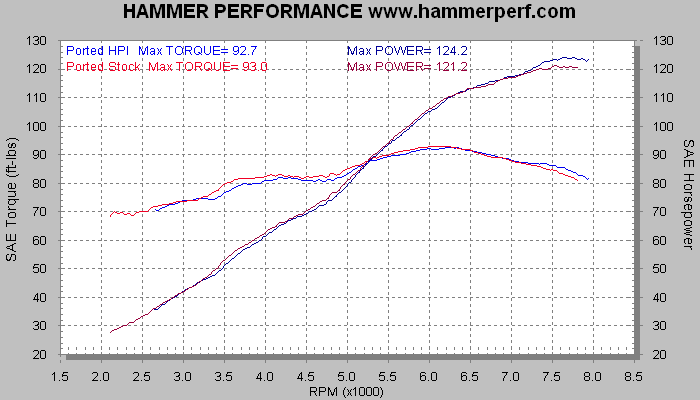
Comparison of the ported HPI 51mm x 1.710 throttle body to the ported factory throttle body
with the 110+hp 883-1250 conversion package
Well, it didn't exactly set the world on fire, and we're really moving the gains far to the right to get any, but hey, horsepower is getting hard to come by at this level, and we'll take it.
Eventually we pulled 126hp out of this combination with a few tweaks, but we didn't try the ported stock throttle body in that configuration, so we can't show that comparison.
|
Screamin Eagle 58mm Throttle Body
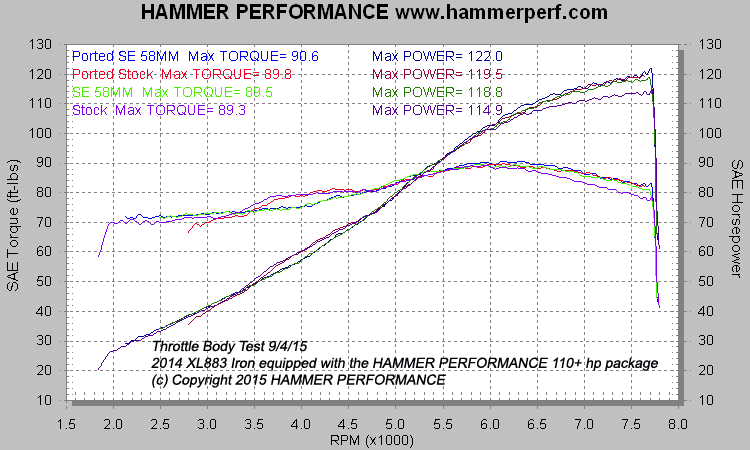
Comparison of the SE 58mm Throttle Body to the stock throttle body,
ported and unported
And finally we come to the SE piece, that came out in late August 2015 and set off a flurry of questions for which we had no answers. Was this the holy grail? Were we finally going to find
a throttle body that really brought something to the party? HD is using it on a 97hp package, why would they do that unless it really helps? We ordered one the day after it was announced to
answer these questions.
Without porting the thing (the green line), our ported stock piece beat it! WTF? A little poking and prodding showed us the reason, we believe. Although this throttle body is huge, and the manifold has
a sewer-pipe sized opening, the manifold outlets were barely bigger than the stock manifold, and noticeably smaller than our ported stock piece. So the losses at the outlets were swamping any losses that were
eliminated upstream by the monstrous
throttle plate. The rest of the manifold was actually very well done, with a good shape and a good surface finish and no casting flash or other imperfections. The outlet size was just all wrong.
So we did what we do, and broke out the die grinder, and proceeded to carve on the manifold, focusing on the same things we focused on with the HPI manifold, the outlets and the injector bosses. Unfortunately, the
outlet o.d.'s are stock as well, so we really weren't able to open it up as much as we'd like. But we did what we could. You can see the result in blue - we picked up 3.2hp over it's out-of-the-box configuration,
which ain't too shabby.
People were asking, though, how it compared to the stock, unported throttle body. We had one laying around so we tossed it on and mapped it in. The gap between the ported and stock version of the original manifold grew from 3hp
in our first test above, to 4.6hp in this test. Not surprising since we're talking about a roughly 10hp stronger motor.
This unit, like the HPI, sticks the throttle body way out there. Both of these things are essentially using throttle bodies that were made for Twin Cams, and to get them to fit between the heads on an XL, they're sticking
them out farther. We really don't like that at all. Like the HPI, this SE unit also requires a special air cleaner. Where the HPI has a CV type air cleaner bolt pattern however, the SE unit has a special one that appears to match
larger Twin Cam throttle bodies. They get $500 for this throttle body kit, but then you need to go spend $350 more for one of their air cleaners.
There's one other thing that should be mentioned here, too, and it's important. When we went to go map this thing, we immediately noticed that giving it full throttle caused a throttle position reading of zero on our
tuner, a Dynojet Powervision. We could back the throttle off ever so slightly and the throttle position would jump up to 100%, but at full throttle, it registered zero. That could really screw up the fueling!
We tried another throttle position sensor, same thing. It was obvious that something was wrong. Either they put the screw holes for the TPS in the wrong place when they machined the throttle body, or
the throttle stop was in the wrong place, but the TPS was most definitely over-rotating when the throttle plate was opened to it's stop. We ended up backing off the pull cable adjustment a bit
to keep it from over rotating. That made the throttle plate not perfectly horizontal at full throttle, however, we don't believe it had any bearing on the results, because the thing is so huge anyway that
there's no real restriction from a degree or two of throttle closure from wide open. But if you get one of these throttle bodies, do check it. Something is made wrong on ours. The folks at SE have some work to do.
We would've liked to test the HPI against the SE, and we even made the attempt, however, this particular iteration of the motor didn't allow for proper mounting of the HPI, too much had been milled off the decks of the
heads and it just wouldn't fit properly. We suspect it's going to come out real close to the SE piece, however, and we'll run that test and add the result here when we get the opportunity.
|
Conclusion
Here are the cold hard facts: these aftermarket throttle bodies are expensive, they stick out farther, they lock you into the company's air cleaner, and in unported form, they don't bring
much if anything to the party when compared to a $100 porting service on your stock throttle body. That's the answer in a nutshell.
Now for a heavy dose of opinion: if someone would actually engineer the thing for an XL, keeping it in the stock location and able to use standard air cleaners, and properly design the manifold (which is the real bottleneck), and bring
the whole thing in at a price point that makes sense, they'd have a winner. As it is, the only way you can really justify one of these things is if you're doing a very high power build and you want every last
horsepower and money is no object. But do have it ported, otherwise it's just a waste of money.
If we had to choose between the SE and the HPI units, we'd go for the HPI in a heartbeat, for two reasons. Number one, the outlets on the manifold are bigger, both out of the box and after porting (the latter since the o.d. is bigger).
This means that ultimately, it should be able to support more power, even with a smaller throttle plate, as the throttle plate's restriction is a much smaller percentage of the total losses than the manifold outlets.
Number two, the air cleaner bolt pattern is stock CV, which at least leaves the door open to running your favorite air cleaner, if you can solve the issue with it sticking out farther and therefore needing some different mounting arrangement
to the head breather bolts.
|
|
|
|

|
|
|










